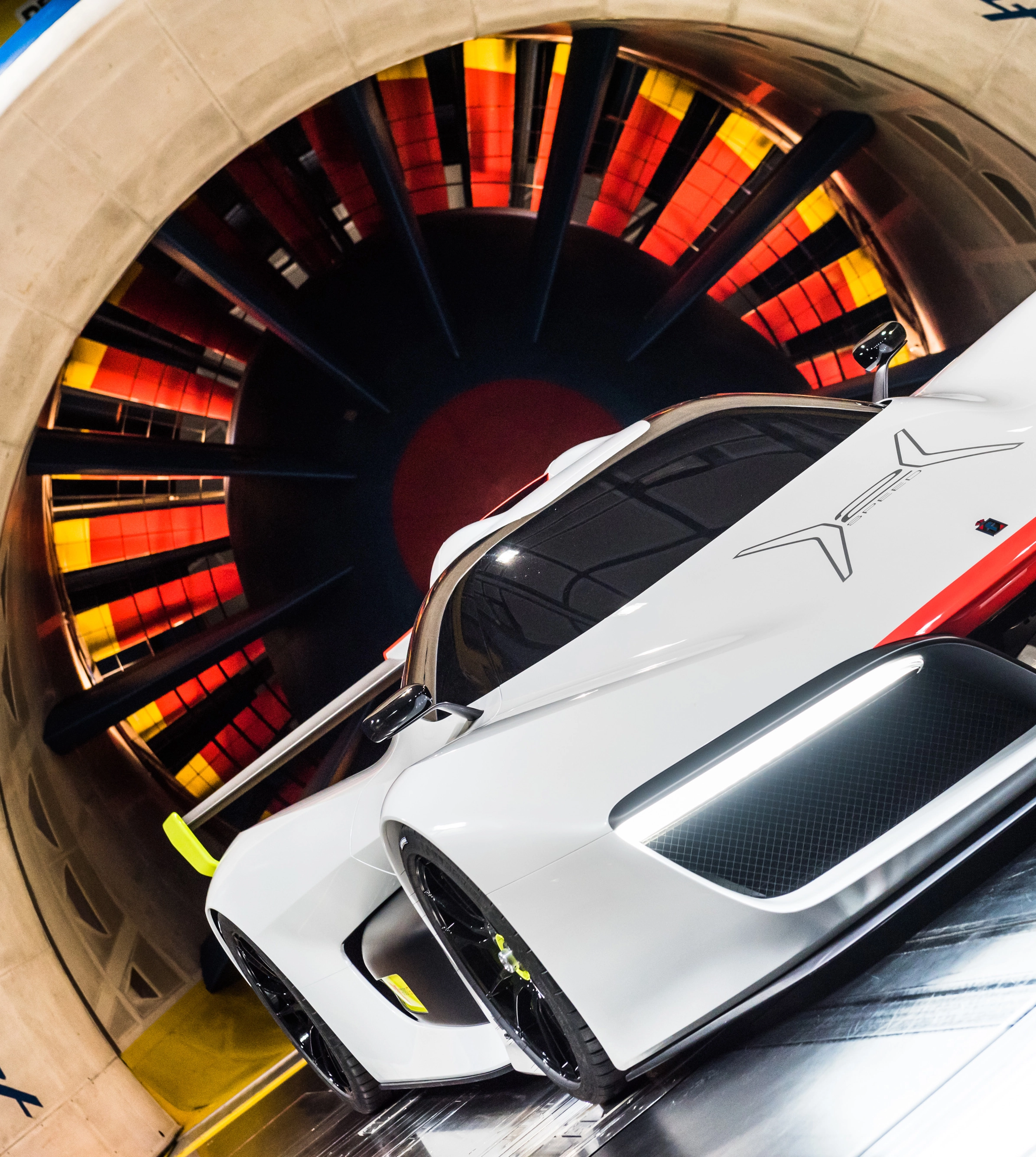Pininfarina Wind Tunnel is active in the aerodynamic and aeroacoustic field, mainly on full-scale passenger cars
Wind Tunnel Services
- Aerodynamic Testing
- Aeroacoustic Testing
- Building Architecture Testing
Aerodynamic Testing
The Pininfarina Wind Tunnel is a precision tool for conducting aerodynamic tests. The constant introduction of cutting-edge technologies and methodologies allows for continupous improvement in th realism and accurancy of the measuremnets taken. For example, the relative movement of the ground plane to the vehicle is replicated using the Ground Effect Simulation System, greatly enhancing the accuracy of the underbody flow features. Furthermore, ambient wind, overtaking and wind gusts can be emulated with the Turbulence Generation System, allowing for aerodynamic and aeroacoustic analysis in realistic flows conditions. In addition to aerodynamic force measurements, the wind tunnel offers a gamut of measurement techniques capable of capturing cooling flows, pressure fields, vorticity and reverse flow regions.
Ground Effect Simulation System
The Ground Effect Simulation System (GESS) replicates the relative movement between the ground and a moving vehicle. The system consists of four rollers and three synchronized moving belts with the flow velocity. The three belts cover the width of the vehicle ahead of the front axle, with the central one running underneath the entire length of the vehicle. This configuration provides an excellent approximation of ground effect at the front of the vehicle, ideal for high-performance applications and motorsport.
Turbulence Generation System
The Turbulence Generation System (TGS) utilizes five pairs of flapping wings upstream of the vehicle to generate turbulence at frequencies across the entire Von Karman spectrum. A variety of flow conditions can be replicated by varying the flapping frequencies and phases of the TGS. Using this system, clients can attain aerodynamic and aeroacoustic measurements that more accurately represent real world conditions. The TGS is capable of reproducing:
• The wake of a downforce producing vehicle
• The wake of a lift producing vehicle
• Ambient wind conditions (High and low traffic)
• Initial phase of a vehicle overtaking manoeuvre
• Continuous yaw angle variations
• Wind gust (frontal and lateral)
Flow Visualization and Measurement
Pininfarina offers a variety of flow visualization and measurement techniques gained over decades of research and development. The proprietary PF14 pressure probe can be used for the rapid measurement of velocity and pressure fields, vorticity and micro-drag along a plane yielding valuable information for the evaluation of a given flow field and correlation to CFD simulations. Pininfarina also offers optical methods such as 3D stereoscopic PIV, pressure-based methods, and vane anemometry methods for the measure of both external and cooling flows.
Aeroacoustic Testing
Whether in the cabin of a car, at the helm of a yacht, or on the balcony of a high-rise building, aeroacoustic noise can have a drastic impact on user comfort and perception. Regardless of the application, the Pininfarina wind tunnel is well equipped to identify and characterize aeroacoustic noise. The wind tunnel employs frontal, lateral, and overhead external microphone arrays in conjunction with beamforming analysis to pinpoint external aeroacoustic noise sources. Interior noise can be quantified via four calibrated acoustic heads or visualized via a spherical microphone array allowing for the identification of noise ingress points.
Building Architecture Testing
The competencies of the Pininfarina Wind Tunnel extend well outside of the automotive sector. For example, scale models of buildings as well as full sized architectural components are evaluated in the wind tunnel to determine aerodynamic and aeroacoustics performance.
Depending on the geometry, certain architectural features can introduce excessive vibration and wind loading on the building, jeopardizing its structural integrity. Furthermore, incorrect design or placement of architectural elements can introduce significant wind noise at street level as well as for building occupants. Therefore, aerodynamic and aeroacoustics performed in the wind tunnel are critical to identifying and solving potential issues, ensuring maximum levels of structural performance and noise comfort.
Applications
Aerodynamics and aeroacoustics of vehicles
Passenger cars
Racing Cars
Low-drag research cars
Heavy trucks (scale models)
Two-wheeled vehicles
Aircraft (scale models)
Industrial vehicles
High-speed trains (scale models)
Components (open roofs, soft-tops, internal flows, radiators, ski-racks, etc.)
Wind engineering, sport and others
Buildings (scale models or sections)
Infrastructure (scale models or sections)
Bridges (scale models or sections)
Sporting goods
Athletes
